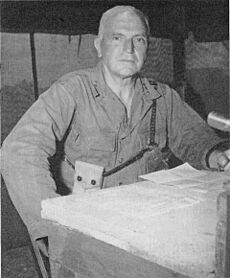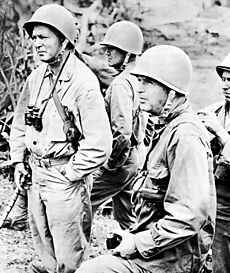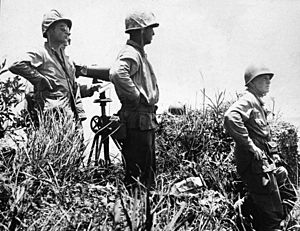Simon Bolivar Buckner Jr. facts for kids
Quick facts for kids
Simon Bolivar Buckner Jr.
|
|
|---|---|

Buckner as a brigadier general in 1940
|
|
| Born | July 18, 1886 Munfordville, Kentucky, United States |
| Died | June 18, 1945 (aged 58) Okinawa, Japan |
| Allegiance | United States |
| Service/ |
United States Army |
| Years of service | 1908–1945 (killed in action) |
| Rank | General (posthumous) |
| Service number | 0-2730 |
| Unit | Infantry Branch |
| Commands held | Tenth United States Army Alaska Defense Command 22nd Infantry Regiment |
| Battles/wars | World War I |
| Awards | Distinguished Service Cross Army Distinguished Service Medal Navy Distinguished Service Medal Purple Heart |
| Spouse(s) | Adele Blanc Buckner |
| Relations | Simon Bolivar Buckner (father) |
Simon Bolivar Buckner Jr. (July 18, 1886 – June 18, 1945) was an important lieutenant general in the United States Army. He served during World War II in the Pacific Ocean area.
As the leader of the Alaska Defense Command, Buckner led American and Canadian forces. They fought in the Aleutian Islands campaign. This included battles like the Battle of Attu and the mission to take back Kiska. Later, he was promoted to lead the Tenth Army. This army carried out the major invasion of the Japanese island of Okinawa in 1945.
Buckner was killed during the final days of the Battle of Okinawa. He was hit by enemy artillery fire. This made him one of the highest-ranking United States military officers to die in combat during World War II. He was one of four lieutenant generals killed in the war. Buckner and another general, Lesley J. McNair, were later given the higher rank of four-star general after their deaths.
Contents
Early Life and Education
Simon Bolivar Buckner Jr. was the son of Confederate general Simon Bolivar Buckner. His mother was Delia Hayes Claiborne. Both Buckner and his father were named after Simón Bolívar. Bolívar was a famous soldier and leader from Venezuela. He helped several South American countries gain independence from Spain.
Buckner's father was the Governor of Kentucky from 1887 to 1891. He also ran for Vice President of the United States in 1896. Simon Jr. grew up near Munfordville, Kentucky. He even went with his father on his 1896 election campaign.
Military Career
Buckner first attended the Virginia Military Institute. When he turned 18 in 1904, his father asked President Theodore Roosevelt for a special favor. He asked for his son to be accepted into West Point. President Roosevelt agreed, and Buckner graduated from West Point in 1908.
He served two tours of duty in the Philippines. He even wrote a book about his experiences there. During World War I, he worked as a temporary major. His job was to train and discipline young air force cadets.
Between the Wars
For 17 years, starting in 1919, Buckner worked at military schools. He spent four years at West Point. He was a tactical officer, teaching cadets. He also studied at The Infantry School and the Command and General Staff School. He was a very good student and later became an instructor.
He also spent time at the Army War College. There, he was first a student and then an executive officer. He returned to West Point for four more years. He served as Assistant Commandant and then Commandant of Cadets. People remembered his time at West Point as being fair but strict.
In 1936, Buckner began working directly with troops again. He was an executive officer for the 23rd Infantry Regiment in Texas. He was promoted to colonel in 1937. He then commanded the 66th Infantry (Light Tank) and later the 22nd Infantry. From 1939 to 1940, he was the Chief of Staff for the 6th Division.
World War II Service
Protecting Alaska
In 1940, Buckner was promoted to brigadier general. He was sent to Alaska to strengthen its defenses. He became the commander of the Army's Alaska Defense Command. In August 1941, he was promoted to major general. He was known as a very tough leader.
Japanese ships had explored Alaskan waters in the 1930s. Both U.S. and Canadian forces knew an attack was possible. When the U.S. entered World War II, Alaska's defense was already underway. No one knew exactly when or where Japan would strike.
The attack came as a surprise on June 3–5, 1942, at Dutch Harbor. Farther west, Japanese forces captured Kiska and Attu islands. They brought thousands of troops ashore. American commanders, including Buckner, worried that Japan would use these islands as bases. This would allow them to attack cities along the U.S. West Coast.
Lieutenant Paul Bishop, a pilot, remembered Buckner's concerns. He said Buckner worried that Japanese bombers could reach cities like Anchorage, Seattle, and San Francisco. The fear was real because Japan seemed very powerful in Asia and the Pacific.
In June 1942, Buckner ordered the native Aleut people to be moved from their homes. Their villages were burned. The Aleut people were not allowed to return until 1945, after the war ended.
The fight to take back Attu Island lasted almost a year. The Battle for Attu happened over three weeks in May 1943. Many soldiers on both sides were killed or wounded. Of the 2,900 Japanese soldiers, only 28 survived. Many airmen and sailors also died during the Aleutian Campaign.
Buckner later said, "The loyal courage... of our armed forces in Alaska... have turned back the tide of Japanese invasion." He added that they had "opened the road to Tokyo."
In August 1943, Canadian and U.S. soldiers invaded Kiska. However, the Japanese had secretly left the island before the Allied forces arrived. Thick fog helped them escape. Allied commanders did not believe the Japanese had left. For eight days, troops searched the island. They often fired into the fog, sometimes accidentally shooting their own comrades. Many Allied soldiers were killed by friendly fire or accidents. This ended the Aleutian Islands campaign. In 1943, Buckner was promoted to lieutenant general.
Battle of Okinawa
In July 1944, Buckner went to Hawaii. His job was to create the Tenth Army. This army included both Army and Marine Corps units. The Tenth Army was originally supposed to invade Taiwan. However, that plan was canceled. Instead, Buckner's command was ordered to prepare for the Battle of Okinawa.
The Battle of Okinawa began on April 1, 1945. It became one of the largest and bloodiest battles in American military history. Buckner chose to attack the Japanese defenses head-on. This strategy was very costly in American lives, but it was successful.
Late in the battle, Buckner did not realize that the Japanese were moving back to a new defense line. This allowed many Japanese forces to escape. Fighting these remaining forces in the southern part of the island caused many more casualties. This included a huge impact on the local civilian population.
Death in Battle
On June 18, 1945, Buckner visited a forward observation post. This post was about 300 yards behind the front lines. Marine infantry were advancing on a Japanese-held ridge. Buckner's visits sometimes drew enemy fire.
Buckner arrived with his general's three stars showing on his helmet. A nearby Marine outpost saw this and signaled his position. They could clearly see the stars. When told, Buckner quickly swapped his helmet for an unmarked one.
As Buckner stood at the outpost, a small Japanese artillery shell hit a rock nearby. Fragments from the shell struck his chest. Buckner was carried to a medical aid station. He died on the operating table. Marine General Roy Geiger took over his command. A total of 12,513 American soldiers died during the Battle of Okinawa.
Personal Life
Simon Bolivar Buckner Jr. was married to Adele Blanc Buckner (1893–1988). They had three children together. Their names were Simon Bolivar Buckner III, Mary Blanc Buckner, and William Claiborne Buckner.
Legacy and Memorials

Many places and things have been named in honor of Simon Bolivar Buckner Jr.:
- Fort Buckner: An Army base on Okinawa, Japan. It has a small memorial to him.
- USNS General Simon B. Buckner (T-AP-123): A troop transport ship.
- Buckner Bay: Nakagusuku Bay on the east side of Okinawa. American military personnel nicknamed it "Buckner Bay" in the 1940s.
- Camp Buckner: At West Point. This is where new sophomores go for field training.
- Buckner Gymnasium: At Fort Richardson in Anchorage, Alaska. Buckner helped establish this post during World War II.
- Buckner Building: In Whittier, Alaska. It was once the largest building in Alaska by size.
- Buckner Drive: In Anchorage, Alaska, originally built as military housing.
- Buckner Drive: In Fort Leavenworth, Kansas.
- Buckner Avenue: In Fort George Meade, Maryland.
- Buckner Gate: At Fort Shafter, Hawaii.
- Buckner Hall: The Headquarters Building at the former Fort McClellan.
- Buckner Circle: The street at the former Fort McClellan where senior officer homes were located.
- Buckner Road: In Mount Vernon, Virginia, named along with roads for other U.S. Army generals.
Military Awards
Buckner received several military decorations and awards:
| Distinguished Service Cross | Army Distinguished Service Medal | ||
| Navy Distinguished Service Medal | Purple Heart | World War I Victory Medal | |
| American Defense Service Medal | Asiatic-Pacific Campaign Medal | World War II Victory Medal | |
Dates of Rank
This table shows when Simon Bolivar Buckner Jr. received his military ranks:
| Insignia | Rank | Component | Date |
|---|---|---|---|
| No insignia | Cadet | USMA | June 16, 1904 |
| No insignia in 1908 | Second Lieutenant | Regular Army | February 14, 1908 |
| First Lieutenant | Regular Army | August 5, 1914 | |
| Captain | Regular Army | May 5, 1917 | |
| Major | Temporary | August 5, 1917 | |
| Captain | Regular Army | August 21, 1919 | |
| Major | Regular Army | July 1, 1920 | |
| Lieutenant Colonel | Regular Army | April 1, 1932 | |
| Colonel | Regular Army | January 11, 1937 | |
| Brigadier General | Regular Army | September 1, 1940 | |
| Major General | Army of the United States | August 4, 1941 | |
| Lieutenant General | Army of the United States | May 4, 1943 | |
| General | Posthumous | July 19, 1954 |





